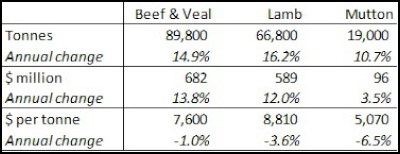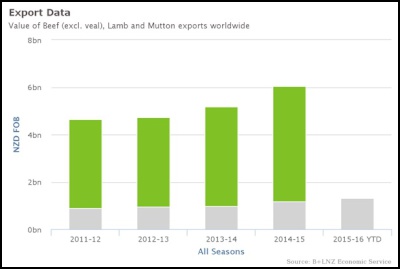Average meat export returns down despite NZD depreciation
Average meat export returns down despite NZD depreciation
The first quarter of the 2015-16 meat export season concluded on 31 December 2015 and analysis by Beef + Lamb New Zealand's Economic Service shows that total red meat (including beef, veal, lamb and mutton) export revenue reached a record high over the quarter. The record was driven by increased shipments however, average per tonne values were down, despite the New Zealand dollar (NZD) depreciation.
October to December 2015: Beef & veal, lamb and mutton exports

Beef: Strong rise in export revenue boosted by large shipments
New Zealand beef and veal exports generated $682m in the first quarter of 2015-16, up 14% compared with the same period last season. This reflected a 15% increase in shipments, while the averageper tonne value was down 1%.
Exports to North America, the largest destination for New Zealand beef and veal exports, remained unchanged compared with the previous season – at levels 33% higher than the five-year average. This mainly reflected strong demand for beef in the US. However, the average value of exports to North America was down 8.2%, despite a 15% depreciation of the NZD against the USD over the period. The decline reflected a 14% drop in processing beef’s average value, which was partly offset by rises in the average value of other cuts.
A strong North Asian appetite for New Zealand beef and veal led to a 55% increase in shipments and a 7.3% rise in the average per tonne value. Beef and veal exports to North Asia totalled 31,000 tonnes from October to December 2015 – nearly equivalent to the five-year average volume exported to North America for the same period.

Lamb: Shipments up, average value down
New Zealand lamb export returns reached a record high of $589m from October to December 2015, up 12% on the same period in 2014. This reflected a 16% increase in shipments, which was partly offset by a 3.6% decline in the average value. The average per tonne value decline occurred despite the weaker NZD.
Demand was particularly strong in the European Union and North Asia, where shipments increased by 24% and 18%, respectively. Strong demand from the European Union led to a slight improvement in the average value (+0.8%) of exports to the region. However, in the case of North Asia, the rise in shipments coincided with a 16% drop in the average value. This highlights the economic slowdown and uncertainties in China.
This downward trend in the average value hides differing performance for chilled and frozen lamb exports. Comparing the first quarter of 2015-16 with the first quarter of 2014-15, the average value of chilled lamb exports improved by 4.5%, while the average value of frozen lamb exports dropped 8.5%. In terms of volume, chilled lamb accounted for 28% of total lamb exports over both the 2014-15 and 2015-16 December quarters.
Mutton: Mutton shipments boosted by a rise in production
Mutton export returns reached a record high of $96m in the first quarter of 2015-16. This reflected a rise in shipments, which was partly offset by a decrease in the average value. Dry conditions, particularly in northern parts of the South Island, boosted mutton production and export volumes.
Mutton exports averaged $5,070 per tonne, 6.5% down on the same period in 2014-15. The decrease would have been larger without the depreciation of the NZD. The largest decrease in average value occurred in North Asia, which is the largest market region for New Zealand mutton exports.
NZ farm-gate prices
New Zealand farm-gate
prices for lamb and mutton dropped over the first quarter of
the season following a normal seasonal decline, however the
decline was greater than in previous years and was driven
by:
- Dry conditions, which led to an increase in
New Zealand sheepmeat production over the first quarter of
2015-16 compared with the same
quarter in 2014-15;
-
Weaker than expected markets, particularly for frozen
exports, which resulted in lower average export receipts;
and
- Weaker co-product lamb and sheep skins
returns than in the same period last season .
Farm-gate prices for cattle remained at near-record high levels, after several months of increases in 2015, but are expected to start easing as US demand for beef slows down .
The B+LNZ Economic Service will review its
farm-gate price forecasts in the 2015-16 mid-season update
report to be published in late February.
Please note
that all values quoted are FOB (free on board) and in New
Zealand dollars and all volumes are in tonnes shipped
weight.
For more information please contact:
B+LNZ chief economist, Andrew Burtt on 027 652 9543 or B+LNZ
communications manager, Jan Keir-Smith on 027 271
7593.
Meat exports interactive
tool
B+LNZ has developed an interactive tool for further analysis of New Zealand's meat exports. The tool allows you to generate and download customised data and graphs of export lamb, mutton and beef statistics, by market, value, and volume. Access it at: portal.beeflambnz.com/tools/export-tool
About Beef + Lamb New Zealand:
Beef
+ Lamb New Zealand Ltd is the farmer owned industry
organisation working for a confident and profitable sheep
and beef industry. It works to help farmers make informed
business decisions and promote their collective interests.
Priorities include investing in research and development
that meets the needs of farmers and the sector, developing
farm and farmer capability and delivering knowledge that
drives farm performance. It also works to attract and retain
talent for the sector, supports the sector’s market
opportunities, advocates for farmers ability to operate and
builds sector confidence and profile within communities.
ENDS


 Federated Farmers: Government Ends War On Farming
Federated Farmers: Government Ends War On Farming University of Auckland: NZ Researchers Drive Work On International AI Framework
University of Auckland: NZ Researchers Drive Work On International AI Framework Woolworths: Rolling Out Team Safety Cameras To All Stores As Critical Tool For De-escalating Conflict
Woolworths: Rolling Out Team Safety Cameras To All Stores As Critical Tool For De-escalating Conflict  Consumer NZ: Environmentally Conscious Shoppers At Risk Of Being Greenwashed
Consumer NZ: Environmentally Conscious Shoppers At Risk Of Being Greenwashed Hugh Grant: Facing The Future - The Use Of Biometric Tech
Hugh Grant: Facing The Future - The Use Of Biometric Tech John Mazenier: Gaffer Tape And Glue Delivering New Zealand’s Mission Critical Services
John Mazenier: Gaffer Tape And Glue Delivering New Zealand’s Mission Critical Services



